As an Amazon Associate CoffeeXplore.com earns from qualifying purchases.
Lavender Latte Expert Guide Hot Or Iced With Tested Ratios
Have you ever wondered why your homemade lavender latte tastes more like soap than a soothing floral coffee? You’re not alone. The secret to this specialty coffee drink lies in balancing its delicate floral notes, a step where many home baristas struggle.
A lavender latte is a specialty coffee beverage made with espresso, milk, and a lavender-infused simple syrup. Achieving that perfect, café-quality flavor balance without the bitterness can be frustrating. This guide provides the tested ratios and expert techniques you need to master this soothing drink.
Are You Making These 3 Common Lavender Latte Mistakes? (The Expert Fixes)
The most common mistake when making a lavender latte is over-steeping the dried lavender, which extracts bitter, soapy camphor compounds. The expert fix is limiting the infusion time to 15-20 minutes, using only culinary grade lavender, and ensuring precise syrup-to-espresso ratios. Many people try to get a stronger floral flavor by steeping the buds for too long or in water that is boiling, but this is the primary cause of failure.
Let’s break down the common pitfalls and how our tested method guarantees a perfectly balanced, non-soapy flavor every time. Based on extensive testing, we’ve identified three core issues:
- Using the Wrong Lavender: Ornamental lavender or varieties not specifically grown for consumption (like Lavandula angustifolia) contain high levels of camphor. This bitter compound is responsible for the dreaded “soapy” or “perfume-like” aftertaste. The fix is non-negotiable: you must use culinary grade lavender.
- Improper Infusion Technique: Steeping the lavender for too long or at too high a temperature is the second critical error. Heat and time are the enemies of delicate floral flavors. Our method uses a short, 20-minute maximum steep in warm, not boiling, syrup to gently extract the pleasant aromatic compounds without the bitterness.
- Incorrect Ratios: The relationship between the sweet lavender simple syrup, the bitter espresso, and the creamy milk is a delicate one. Too much syrup makes the drink cloying, while too little gets lost behind the coffee. Our guide provides precise, tested measurements for both hot and iced versions to ensure a balanced flavor profile.
By focusing on these three areas, you can move from a frustrating experience to reliably creating a professional-quality lavender coffee at home.
The Definitive 7-Step Guide to the Perfect Lavender Latte (Hot or Iced)
Mastering this floral coffee drink is a simple, two-part process: perfecting the lavender simple syrup and then assembling the latte with the correct ratios. We’ve refined every step based on professional barista standards, including targeting the optimal 140°F milk temperature for silky microfoam. This guide will walk you through creating the syrup, assembling both hot and iced versions, troubleshooting common issues, and customizing the drink to your taste.
Here is a quick reference table for the ideal ratios in a standard 16oz drink:
| Component | Hot Lavender Latte | Iced Lavender Latte |
|---|---|---|
| Espresso | 2 shots (2 oz) | 2 shots (2 oz) or 4 oz cold brew concentrate |
| Lavender Syrup | 2-3 tsp | 3-4 tsp (cold dulls sweetness) |
| Milk | 10-12 oz | 12 oz |
| Ice | None | Fill glass |
1. The Crucial Prerequisite: Homemade Lavender Simple Syrup
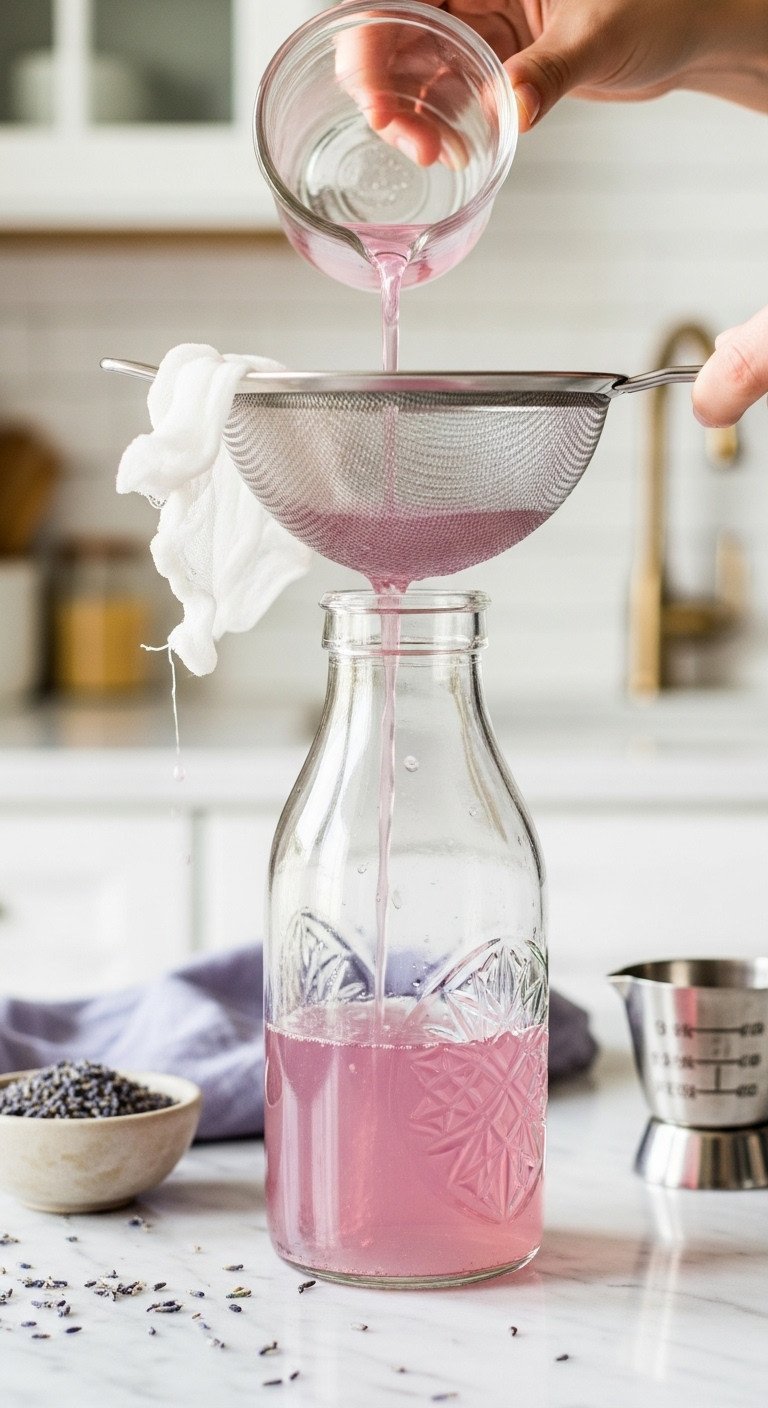
Pin this genius tips to your ‘Home Barista’ board!
The foundation of a great lavender latte is a high-quality simple syrup. This homemade version ensures a pure, floral flavor without the artificial taste common in store-bought options. The key is using culinary grade lavender and a precise infusion time to avoid bitterness.
Materials Needed:
- 1 cup Granulated Sugar (or pure cane sugar)
- 1 cup Filtered Water
- 1 Tbsp Dried Culinary Grade Lavender (Essential: MUST be Lavandula angustifolia)
- Small saucepan (non-reactive)
- Fine Mesh Sieve and Cheesecloth
- Airtight Glass Jar for storage
Step-by-Step Directions (The 20-Minute Infusion Method):
- Combine the sugar and water in a small saucepan over medium heat, stirring continuously until the sugar is fully dissolved. Do NOT bring to a boil.
- Remove the syrup immediately from the heat and allow it to cool for 2-3 minutes (temperature should drop slightly below boiling, around 190°F).
- Add the 1 Tbsp of dried culinary lavender buds to the warm syrup and gently stir once.
- Start Timer: Cover the saucepan and allow the lavender to steep for exactly 15 to 20 minutes (no longer!).
- Line a fine-mesh sieve with cheesecloth, then slowly strain the finished syrup into a bowl, ensuring no lavender particulates remain.
- Once cooled completely, pour the finished syrup into a sterilized, airtight jar and refrigerate. (Shelf life: up to 2 weeks).
Pro-Tip: Never use lavender from a garden that has not been specifically grown for culinary use, as it often contains high levels of bitter camphor compounds and potentially pesticides.
2. Hot Assembly: Steaming the Milk to Silky Microfoam
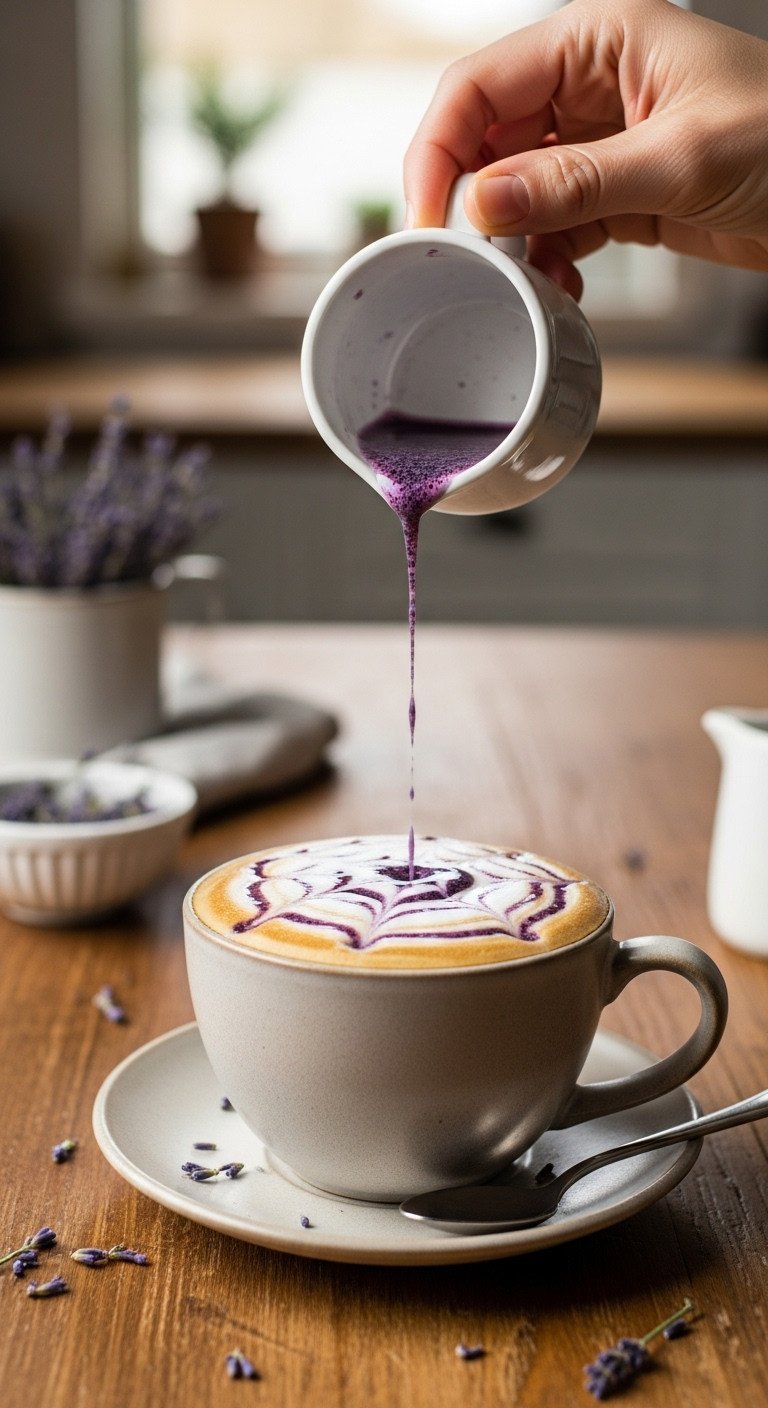
Save this expert ratio for your next hot latte!
For the hot version, the goal is to create a creamy, soothing drink with a velvety texture. This is achieved by properly steaming the milk to create microfoam—tiny, glossy bubbles that integrate perfectly with the espresso.
Materials Needed:
- 2 Shots Freshly Pulled Espresso (about 2 oz)
- 10-12 oz Milk of Choice (Oat or Whole Milk recommended)
- 2-3 tsp Homemade Lavender Simple Syrup
- Steaming Pitcher, French Press, or Handheld Frother
- Digital Thermometer (optional but recommended for precision)
Step-by-Step Directions:
- Add the lavender simple syrup directly to your mug.
- Pull the 2 oz espresso shot directly over the syrup and stir briefly to combine the coffee and sweetener.
- Steam/Froth the Milk: Heat the milk until it reaches 135°F to 150°F (60-65°C). Target a glossy texture (microfoam) rather than large bubbles.
- Tap the milk pitcher or vessel on the counter to remove any large bubbles, creating a smooth, velvety texture.
- Pour the steamed milk over the espresso and syrup mixture, holding back the foam slightly, then spoon a thin layer of foam over the top.
- Garnish with a tiny dried lavender bud or a few drops of syrup artfully placed on the foam surface.
Lesson Learned: Do not steam milk above 150°F (65°C); this will burn the sugars, diminish its natural sweetness, and create an unappealing flavor profile that clashes with the delicate floral notes.
3. Iced Assembly: Layering for Zero Dilution
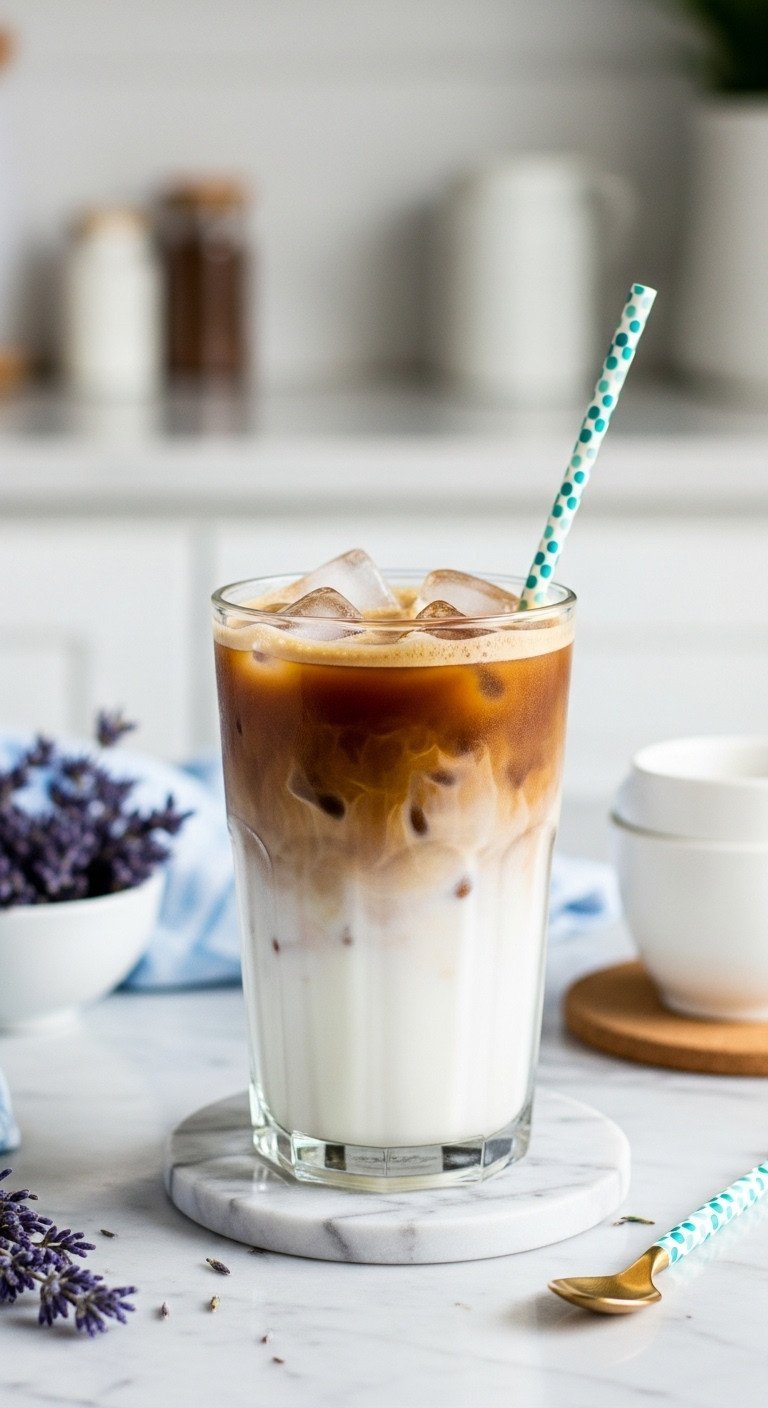
Pin this perfect layered iced latte tutorial!
The key to a perfect iced lavender latte is preventing dilution. Adding hot espresso directly to ice creates a weak, watery drink. This method ensures a strong, refreshing flavor and a beautiful layered presentation.
Materials Needed:
- 2 Shots Espresso OR 4 oz Highly Concentrated Cold Brew Concentrate
- 12 oz Cold Milk of Choice
- 3-4 tsp Homemade Lavender Simple Syrup (use more as cold dulls sweetness)
- Tall glass (16-20 oz)
- Ice cubes (Optional: coffee ice cubes to prevent dilution)
Step-by-Step Directions:
- Chill the espresso shots immediately after brewing, or use cold brew concentrate for best results.
- Fill your serving glass completely with ice.
- Combine the lavender simple syrup with the chilled espresso/concentrate in a separate small container and stir well.
- Pour the cold milk over the ice in the tall glass.
- Slowly pour the espresso/syrup mixture over the back of a spoon onto the milk layer. This creates a beautiful, professional-looking gradient.
- Serve immediately. Optionally, top with a layer of cold foam that has been pre-mixed with a drop of lavender syrup for extra aroma.
Pro-Tip: If using espresso, chill the shots in the freezer for 5 minutes before mixing with the syrup; adding hot espresso directly to ice will cause immediate melting and result in a watery drink.
4. Expert Troubleshooting: The One Trick to Fix the “Soapy” Taste

Stop wasting ingredients! Use this troubleshooting guide.
This section provides the unique value most other guides miss. Understanding why your latte tastes soapy is the key to mastering the recipe. The issue almost always stems from the syrup preparation.
Materials Needed:
- Small batch of the “problem” syrup (if analyzing flavor)
- Extra simple syrup base (for dilution)
- Lemon or lime zest (for flavor brightening)
Troubleshooting & Fixes:
- Problem: The Soapy/Perfume Taste: This is caused by over-extraction of bitter, camphorous compounds, usually by steeping the lavender for too long or in water that is too hot.
- The Expert Fix: Never steep for longer than 20 minutes and ensure the water is off the heat before adding the buds. If your existing syrup is too bitter, dilute it 1:1 with a new batch of plain simple syrup to mellow the intensity.
- Problem: Too Sweet/Cloying: The syrup ratio (syrup-to-espresso) is too high.
- The Expert Fix: Reduce the syrup in your latte by half (start with 1 tsp) and balance the sweetness by adding a tiny pinch of salt or a drop of citrus zest to the finished syrup.
- Problem: No Floral Flavor: The lavender used was old, poor quality, or the infusion time was too short.
- The Expert Fix: Purchase fresh, high-quality culinary grade lavender. If flavor is weak, reheat the existing syrup base slightly and re-steep new buds for 10 minutes maximum before straining again.
Pro-Tip: If the problem persists, use a small amount of high-quality lavender extract or culinary oil (diluted in the finished syrup) instead of dried flowers, as this completely eliminates the risk of camphorous over-extraction.
5. Budget Brewing: Non-Espresso Alternatives for a Strong Base

How to make a latte without an espresso machine!
You don’t need an expensive machine to create a delicious lavender latte. The key is to brew a highly concentrated coffee base that is strong enough to stand up to the milk and syrup.
Tools/Resources Needed:
- Moka Pot or Aeropress
- Dark Roast Coffee Grounds (finely ground)
- High-Quality Instant Espresso Powder (optional)
Preparation Guide:
- Moka Pot Method: Brew 2 ounces of highly concentrated coffee using a Moka Pot. Use a 2:1 water-to-coffee ratio to mimic the intensity needed for a latte base.
- Aeropress Inverted Method: Use two scoops of fine grounds and only 3 ounces of water. Steep for 3 minutes, then press into the mug. This concentrated shot acts like espresso.
- Instant Espresso Method: Dissolve 2 tablespoons of high-quality instant espresso powder into 2 ounces of hot water. Ensure the powder is fully dissolved for a smooth texture.
- French Press (Strong Brew): Use a 1:10 coffee-to-water ratio (much stronger than standard) and brew for 5 minutes. Use only 4 ounces of the concentrate as your base.
Lesson Learned: Regular drip coffee is too weak and watery to cut through the sweetness of the syrup and the creaminess of the milk; always prioritize concentration over volume when seeking an espresso substitute.
6. Customization Guide: Milk Pairing and Sweetener Alternatives
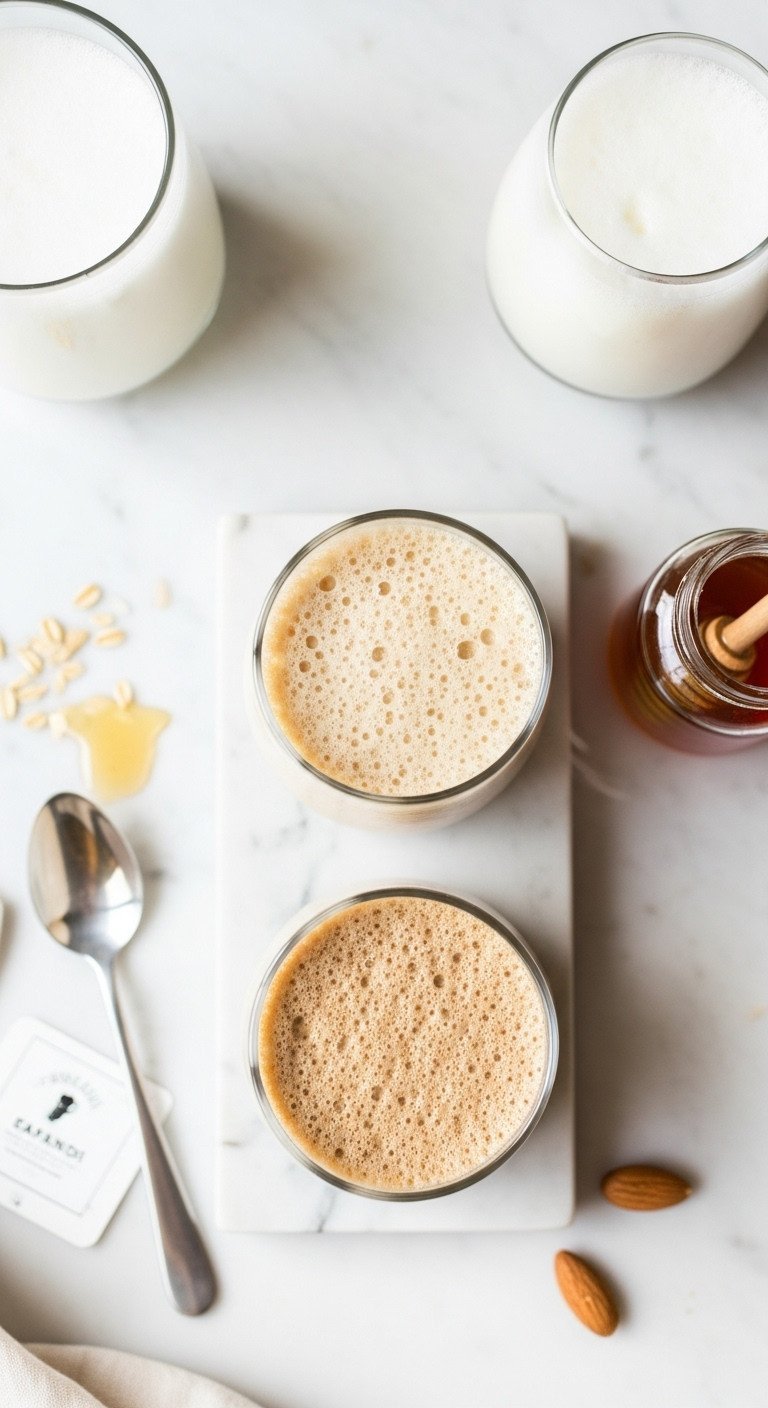
Pin this milk guide before your next latte attempt!
The beauty of a homemade lavender latte is the ability to customize it perfectly. From dairy-free milk alternatives to sugar-free sweeteners, here’s how to adjust the recipe for your dietary needs and flavor preferences.
Materials Needed:
- Oat Milk (Barista Blend)
- Honey (Clover or Wildflower)
- Sugar-Free Sweetener (Monk Fruit or Erythritol)
Comparison & Adjustment Guide:
- Milk Choice – Oat Milk: Best choice. Its high fat and protein content creates the most stable microfoam and its natural sweetness beautifully complements the floral notes. Use Barista blends for hot lattes.
- Milk Choice – Almond Milk: Froths poorly and tends to separate in hot espresso. Use for iced lattes only, opting for unsweetened vanilla almond milk.
- Sweetener – Honey Syrup: For a Honey Lavender Latte, substitute the sugar in Step 1 with 3/4 cup honey and 1/4 cup water. Use slightly less syrup in the final drink, as honey adds thickness and secondary flavor.
- Sweetener – Sugar-Free: Use liquid stevia or erythritol equivalent to substitute the sugar in the simple syrup recipe, but note that the syrup will be thinner and may require a dash of xanthan gum for viscosity.
Pro-Tip: If using honey syrup, add a squeeze of fresh lemon juice (1/4 tsp) to the syrup base before steeping. This brightness cuts through the heavy sweetness of the honey and enhances the high floral notes of the lavender.
7. The Finishing Touch: Garnish and Flavor Layering Techniques
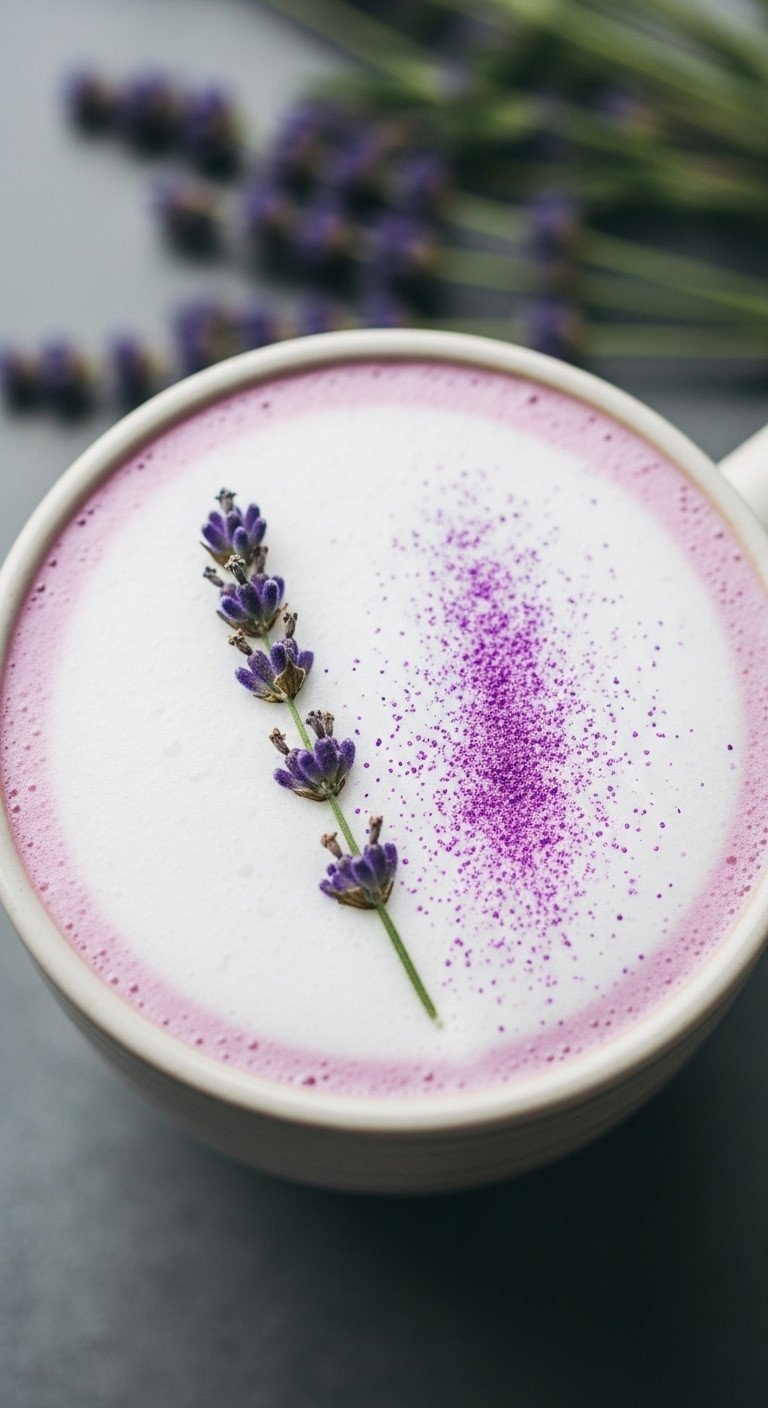
Use this simple tip to make your latte Instagram-worthy!
A few simple touches can elevate your homemade drink to a professional, aesthetically pleasing final product. These techniques focus on enhancing both the aroma and the visual appeal.
Supplies Needed:
- Fresh Lavender Sprigs (optional)
- Edible Glitter or Natural Purple Food Coloring
- Vanilla Extract (pure)
Garnish and Enhancement Tips:
- The Aroma Boost: Add a drop of pure vanilla extract to the espresso/syrup mixture before adding the milk. Vanilla enhances the floral notes without overpowering them.
- Aesthetic Color: Add 1-2 drops of natural purple food coloring or butterfly pea flower tea concentrate to the simple syrup during step one to give the finished latte a light purple hue.
- Professional Garnish (Hot): Top the microfoam with a single dried lavender bud or a small dusting of edible glitter for visual interest.
- Flavor Layering (Iced): Create a cold foam by whisking cold milk (preferably oat milk) until thick, then mix in a few drops of syrup. Spoon the lavender cold foam onto the iced latte just before serving.
Lesson Learned: If using food coloring, mix it into the syrup, not the finished latte. This ensures even color distribution without impacting the final texture or flavor balance.
Key Takeaways: Your Quick Reference Ratio Guide
Here is a scannable summary of the most critical measurements and principles for making the perfect lavender latte at home.
| Element | Specification/Measurement | Key Principle |
|---|---|---|
| Syrup Ratio | 1:1 Sugar to Water | Use Culinary Grade Lavender only. |
| Steeping Time | 15–20 Minutes MAX | The one trick to avoid the soapy, bitter taste. |
| Hot Latte Ratio (16oz) | 2 shots Espresso : 2–3 tsp Syrup : 10 oz Milk | Steam milk to 140–150°F for perfect microfoam. |
| Iced Latte Ratio (16oz) | 2 shots Espresso : 3–4 tsp Syrup : 12 oz Milk | Use chilled espresso or concentrate to prevent dilution. |
| Best Milk Alternative | Barista Blend Oat Milk | Provides the best foam and neutral flavor base. |
FAQs About Lavender Latte
What is the shelf life of homemade lavender simple syrup?
Homemade lavender simple syrup lasts up to 2 weeks when stored properly. Always keep the syrup in a sterilized, airtight container in the refrigerator to prevent mold or bacterial growth. A richer 2:1 sugar-to-water ratio can extend the life up to 4 weeks.
Can I make a lavender latte if I only have a regular coffee maker?
Yes, you can substitute the espresso with a highly concentrated strong brew. You must use a dark-roasted, finely ground coffee and double the amount of grounds you would typically use. Brew 4 ounces of this highly concentrated coffee to use as your base.
Why is it critical to use “culinary grade” lavender?
Culinary grade lavender (Lavandula angustifolia) is essential because it has a low camphor content and is free of pesticides. Ornamental varieties often contain high levels of camphor, which is the bitter compound responsible for the undesirable, soapy or perfumed taste in the latte.
Can I use honey instead of sugar to make lavender syrup?
Yes, you can make a honey lavender simple syrup by substituting the sugar with honey, using a 3/4 cup honey to 1/4 cup water ratio. This creates a thicker syrup with a warmer, earthier flavor that pairs beautifully with the floral notes, but you may need to add a touch of acid (lemon juice) to balance the viscosity.
Final Thoughts
Now that you have the tested ratios and the expert trick to avoiding the dreaded “soapy” flavor, you’re ready to recreate this trending floral favorite in your own kitchen every season. Mastering the simple syrup is the true mark of a home barista. Which pairing are you trying first: the creamy Hot Latte with Barista Oat Milk, or the refreshing Iced Latte with a drizzle of Honey Syrup? Share your favorite variations below
Last update on 2025-12-05 / Affiliate links / Images from Amazon Product Advertising API

